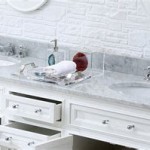How To Paint A Bathroom Vanity Without Sanding
Revitalizing a dated bathroom vanity with a fresh coat of paint can dramatically enhance the space's aesthetic appeal. However, the traditional approach of sanding down the existing finish before painting can be time-consuming and messy. Fortunately, modern paint technology offers solutions for painting bathroom vanities without the need for laborious sanding. This article will explore effective techniques for achieving a smooth and durable finish on your bathroom vanity without the hassle of sanding.
Prepare the Surface
While sanding may be omitted, thorough surface preparation is crucial for successful paint adhesion. Begin by cleaning the vanity thoroughly with a degreaser to remove any dirt, grime, soap residue, or oils that may interfere with the paint's bonding. Pay close attention to the handles, knobs, and other hardware, as these areas often accumulate grime. Once the vanity is cleaned, allow it to dry completely before proceeding.
Next, carefully examine the surface for any loose or peeling paint. Gently scrape away any loose paint using a scraper or putty knife. If there are significant chips or cracks, consider using a wood filler to repair these imperfections before painting. This step ensures a smooth and even surface for the new paint to adhere to.
Utilize Primer
Primer acts as an intermediary layer between the existing surface and the paint, promoting better adhesion and a more even finish. Choose a primer specifically designed for surfaces that will be painted without sanding. Opt for a bonding primer, as it provides superior bonding capabilities and can be applied directly to the existing finish without sanding. Apply the primer evenly to the entire vanity surface using a brush or roller.
Allow the primer to dry completely according to the manufacturer's instructions before proceeding to the next step. This step is crucial as it allows the primer to fully cure, ensuring optimal adhesion and preventing paint from chipping or peeling.
Apply Paint
Now that the surface is prepared and primed, you can begin applying your chosen paint color. Select a high-quality paint specifically formulated for bathroom use, as this type of paint is designed to withstand moisture and humidity. For a smooth finish, consider using a paint sprayer. However, a brush or roller can also be effective, especially for intricate details or hard-to-reach areas. If using a brush, apply the paint in thin, even coats, working in small sections to avoid streaks.
Allow each coat of paint to dry completely before applying the next. Two coats are typically sufficient for a good, opaque finish. After the final coat has dried, consider applying a sealant to provide additional protection and durability. A water-based polyurethane sealant is a good option for bathroom vanities, as it forms a clear, protective barrier that resists moisture.
Alternative Surface Preparation Methods
While sanding is not a requirement, there are alternative methods that can be utilized for surface preparation, depending on the condition of the vanity and personal preference. For example, using a fine-grit sandpaper can be beneficial for removing minor imperfections or rough spots that may hinder paint adhesion. However, this approach should be performed with caution, as excessive sanding can damage the vanity's surface.
Another option is using a liquid deglosser, which effectively removes gloss from the existing surface without sanding. Deglosser helps create a more porous surface that allows the primer and paint to adhere better. However, it is important to choose a deglosser specifically designed for use on painted surfaces.
Important Considerations
It is essential to choose the appropriate paint for your vanity based on its material and the intended use. For example, oil-based paints are known for their durability and resistance to moisture but may require more ventilation during application. Water-based paints are generally easier to apply and clean up but may not offer the same level of durability as oil-based paints.
Additionally, consider the desired finish. If you prefer a glossy or semi-gloss finish, select a paint that provides this type of sheen. Matte or satin finishes are also available, offering different levels of reflectivity and durability.

How To Paint Bathroom Cabinets Without Sanding 8 Vital Steps Grace In My Space
.jpg?strip=all)
Repaint Your Vanity Without Sanding Dream Green Diy

How To Paint Bathroom Cabinets Without Sanding 8 Vital Steps Grace In My Space

7 Easy Steps To Paint Bathroom Cabinets Without Sanding Cottage Living And Style

7 Easy Steps To Paint Bathroom Cabinets Without Sanding Cottage Living And Style
.jpg?strip=all)
Repaint Your Vanity Without Sanding Dream Green Diy

Diy Gel Stain Cabinets No Heavy Sanding Or Stripping Maison De Pax

Yes Paint Over Stained Wood Without Sanding Porch Daydreamer
.jpg?strip=all)
Repaint Your Vanity Without Sanding Dream Green Diy

How To Paint Cabinets Without Sanding A Fresh Squeezed Life
Related Posts







